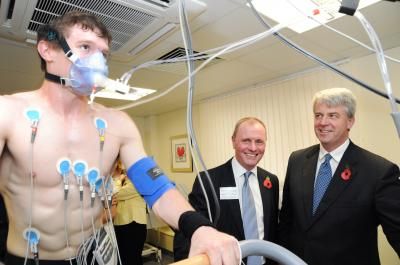Revolutionizing blood pressure measurement
New technology will lead to better treatment decisions and better outcomes for patients
Advertisement
In a major scientific breakthrough, a new blood pressure measurement device is set to revolutionise the way patients' blood pressure is measured. The new approach, invented by scientists at the University of Leicester and in Singapore, has the potential to enable doctors to treat their patients more effectively because it gives a more accurate reading than the current method used. It does this by measuring the pressure close to the heart – the central aortic systolic pressure or CASP.

Professor Bryan Williams (center) and Health Minister Andrew Lansley (right) with Ph.D. student Daniel Timms (left) are at the opening of the University of Leicester Cardiovascular Biomedical Research Unit.
University of Leicester
Blood pressure is currently measured in the arm because it is convenient however this may not always accurately reflect what the pressure is in the larger arteries close to the heart.
The new technology uses a sensor on the wrist to record the pulse wave and then, using computerised mathematical modelling of the pulse wave, scientists are able to accurately read the pressure close to the heart. Patients who have tested the new device found it easier and more comfortable, as it can be worn like a watch.
Being able to measure blood pressure in the aorta which is closer to the heart and brain is important because this is where high blood pressure can cause damage. In addition, the pressure in the aorta can be quite different from that traditionally measured in the arm. The new technology will hopefully lead to better identification of those who will most likely benefit from treatment by identifying those who have a high central aortic systolic pressure value. This will be especially important for younger people in whom the pressure measured in the arm can sometimes be quite exaggerated compared to the pressure in the aorta.
A key question is whether measurement of central aortic pressure will become routine in clinical practice. Professor Williams said: "it is not going to replace what we do overnight but it is a big advance. Further work will define whether such measurements are preferred for everybody or whether there is a more defined role in selective cases to better decide who needs treatment and who doesn't and whether the treatment is working optimally"
The University's close collaboration with the Singapore-based medical device company HealthSTATS International has led to the development of this world-first technique for more accurate blood pressure measurement.
The research work carried out by the University of Leicester was funded by the Department of Health's National Institute for Health Research (NIHR). The NIHR has invested £3.4million with a further £2.2million Capital funding from the Department of Health to establish a Biomedical Research Unit at Glenfield Hospital, Leicester, dedicated to translational research in cardiovascular research. The work, led by Professor Bryan Williams, Professor of Medicine at the University of Leicester and consultant physician at University Hospitals of Leicester NHS Trust, has the promise to change the way we measure blood pressure.
























































